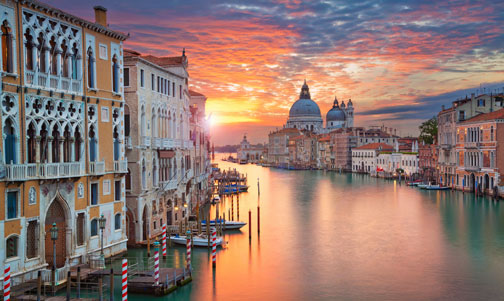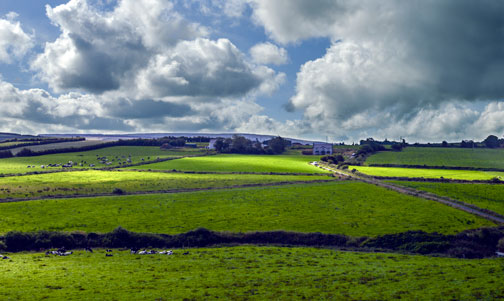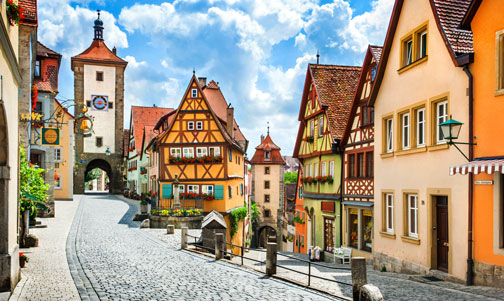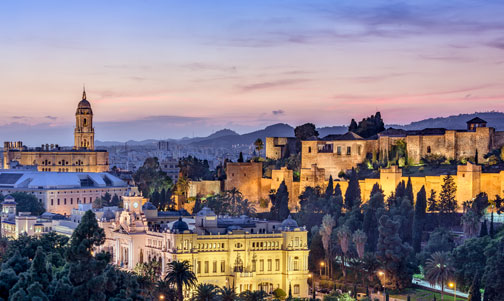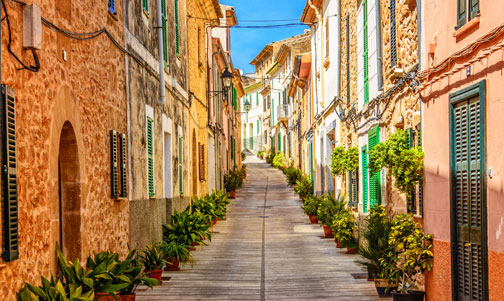Travel Tips for Seniors

Travel Tips For Europe
Though it may seem like parts of Europe are similar to the U.S., there are definitely a few key differences you should prepare for. That’s why we’ve gathered some tips and information that’s good to know for your visit to Europe!
In our Europe travel guide, you’ll learn everything you need to know to ensure a fun and exciting adventure. From a quick glimpse at its history to essential travel tips for Europe, you’ll gain peace of mind knowing you’re ready to embark on your next journey. You’ll also be able to explore some of Road Scholar’s European travel trips that open the doors to some of Europe’s top destinations.
A Full Travel Guide to Europe
If you’re looking for a Europe travel guide, you’re in the right spot. At Road Scholar, we have an expansive collection of travel guides for areas across the globe, including Europe. Having access to a travel guide for your adventure is beneficial for many reasons. You can learn about cultural customs and practices to ensure you’re respectful to the communities you’re visiting, explore off-the-beaten-path areas to better understand an area, and learn about the history and geography that influenced the present-day norms of your destination.
In our Europe travel guide, we’ll provide a list of fast facts to help you grasp what makes Europe so unique, as well as a comprehensive list of tips for traveling to Europe. If you’re interested in a European travel group, use our guide to get prepared.
Europe Fast Facts
- Population: 748,617,895
- Languages spoken: 24 official EU languages, including Bulgarian, Croatian, Czech, Danish, Dutch, English, Estonian, Finnish, French, German, Greek, Hungarian, Irish, Italian, Latvian, Lithuanian, Maltese, Polish, Portuguese, Romanian, Slovak, Slovenian, Spanish and Swedish.
- Currencies: Euro, Bosnian Convertible Marka, Bulgarian Lev, Croatia Kuna, Czech Koruna, Danish Krone, British pound, Hungarian Forint, Macedonian Denar, Norwegian Krone, Polish Zloty, Romania New Leu, Serbian Dinar, Swedish Krone, Swiss Franc, Turkish Lira
- Total size: 3,938,000 square miles
- Coastline: 41,000 miles
- Number of countries: 51
- Major cities: London, Paris, Berlin, Madrid, Florence, Munich, Moscow, Istanbul, Rome, Kyiv, Saint Petersburg, Barcelona
Europe Travel Tips
Are you ready for a European travel adventure? Whether you’re exploring Western Europe or spending the winter in Southern Europe, these travel tips for Europe will prove useful wherever you go. Take a look:
|
Bring travel visas: Starting in 2025, U.S. citizens coming to the EU will need an ETIAS Visa.
Book early: Book European accommodations early because hotels and attractions get very full.
Research public transportation: Before you show up in a new city, be prepared by knowing public transportation options so you can easily get around a city. Get acquainted with the train system in Europe and perhaps buy a Eurail Pass. Make sure to validate your ticket before you get on to avoid extra fees.
International driver’s license: If you plan on driving around Europe, apply for an international driver’s license.
Bring sensible shoes: Traveling through Europe generally means you will be doing a lot of walking. Bring your comfortable, supportive tennis shoes to be ready to walk miles.
Carry cash: Carry some cash on you for those small cash-only restaurants and local markets. And be aware of the local currency – not all European countries are on the Euro.
Travel off-peak dates: To avoid high season prices and large crowds, pick offseason dates to travel to Europe. November through March is a beautiful time to visit Europe with fewer tourists.
Research local budget airlines: If you’re traveling within Europe, there are many budget airlines that can fly you almost anywhere in Europe for little cost. There are often hidden fees and special baggage requirements, so make sure you research before booking.
Pack adapters: Don’t forget your travel adapter! There are many universal ones nowadays, but if you’re getting one for just your country, keep in mind that the UK and Continental Europe have different outlets.
Meet the locals: Shop at small, family owned businesses to really interact with the locals. If you’re headed to a city, chances are you’ll see a lot of tourist trap attractions and restaurants. To fully immerse yourself in your European adventure, journey off the beaten path.
Get your bearings at your hotel: Floors are often numbered differently in Europe. The bottom floor is called the ground floor and what we call the second floor is the European’s first floor. So if your room is on the second floor in Europe, it’s actually on the third floor in America. This also means that anything below the ground floor will be a negative number. In a hotel elevator, 0 will often be the lobby.
Check customs regulations: Look up the US Customs regulations before bringing back any food. There’s restrictions placed on meat, cheeses, produce and other food items brought into the US. |
Book Your Attractions in Advance
Certain attractions are very popular, and it is wise to buy tickets in advance. Making online reservations and purchasing your tickets in advance will save you time and ensure you won’t miss out on top sights because of the crowds. At many places, advanced reservations and tickets mean you get to skip the long line to see the attraction.
Here are the attractions to buy tickets in advance that allow you to skip the long line:
-
Anne Frank House, Amsterdam, Holland
-
Van Gogh Museum, Amsterdam, Holland
-
Rijksmuseum, Amsterdam, Holland
-
Buckingham Palace, London, England
-
The London Eye, London, England
-
Leonardo da Vinci’s The Last Supper, Milan, Italy
-
Pompeii, Naples, Italy
-
Uffizi Gallery, Florence, Italy
-
Michelangelo’s “David” at Galleria dell’Accademia, Florence, Italy
-
The Vatican and Sistine Chapel, Italy
-
Sagrada Familia, Barcelona, Spain
-
Picasso Museum, Barcelona, Spain
-
Real Alcazar, Seville, Spain
-
Louvre, Paris, France
-
Eiffel Tower, Paris, France
-
The Catacombs, Paris, France
-
Pergamon and Neues Museums, Berlin, Germany
What Countries Are in Europe?
Europe is home to some of the oldest countries in the world that have been formed through century-long conflicts, migrations of people, and lengthy empires. Today, much of present-day Europe looks much different than it did a century ago, with the newest country, Kosovo, joining Europe in 2008 after separating from Serbia. Currently, Europe is home to 51 countries, which include:
What Is the European Union?
The European Union is an international organization that governs basic political, economic, social, security, and monetary matters of member states. Currently, there are 27 members of the European Union, including:
The goal of the EU is to create peace and freedom among member states by reducing international borders to make it easier for travelers and citizens to visit, trade, and explore with other EU member states. Additionally, all members of the EU use the same currency, the Euro, to make it easier for citizens and travelers to exchange money for goods with one another.
How to Get Around in Europe
Europe is a vast and populated continent that’s home to over 50 countries represent unique cultures and communities. With that said, getting around Europe can be challenging, as entering each country may require its own customs process if it’s not part of the European Union. However, Europe is at the forefront of public transportation, making it easier for visitors to hop from country to country. Here are some tips on traveling in Europe:
- Train: One of the best ways to get around Europe is by train. There are several rail systems that can bring you throughout Europe, depending on your origin and destination, including Eurostar, SNCF, Deutsche Bahn, FlixTrain, Italo, and Renfe. Not only will taking the train make it easier to get around Europe, but you’ll be able to relax and take in the views of the European countryside, small towns, large cities, and mountainous landscapes.
- Plane: There are dozens of major international airports located throughout Europe, and flying within Europe is often affordable and fast, making it a great option if you’re looking to make it to another destination quickly.
- Subways: Most large cities in Europe, such as Paris, Berlin, and London have subway systems that connect nearly all points of the city. Subways are low-cost and easy to navigate, making them a great option for exploring urban centers without driving.
- Car: If you prefer traveling by car, Europe has one of the best highway systems in the world, making it easy for travelers to get between countries. For example, Germany’s Autobahn system is easy to navigate and get places in a short amount of time.
START TRAVELING IN EUROPE WITH ROAD SCHOLAR
Are you ready to start traveling in Europe? At Road Scholar, we have an expansive collection of European learning adventures to choose from. Whether you’re interested in a European riverboat cruise or a walking tour of a major city, our professional guides will help you discover your destination's culture, geography, landscapes, and cuisine.
With this list of Europe travel tips for seniors, you can rest assured knowing you’re fully prepared for any group travel, from Monaco to Belgium and everywhere in between. Our experiential learning programs consist of diverse cohorts of like-minded adventurers who are eager to learn more about the world around them. You’ll leave with lifelong friends and memories through spirited conversations and active discovery.
Travel Guides
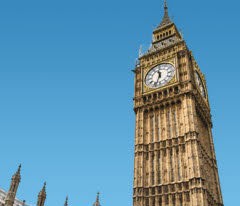

Read on to find out some of the many reasons why England is a top travel destination, and take advantage of our tips, testimonials, reading list and more to help prepare you for your England travel adventure!

From the sun-splashed vineyards of the Loire Valley to the sophisticated charm of Paris, authentic France is best experienced by learning its history, culture and cuisine. Whether you’ve never been to France or are a seasoned traveler, there is always a new way to delight your mind, body and senses.




